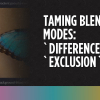
Amazingly deep article on CSS blend modes. Incredible work from Ana Tudor.
difference and exclusion
Amazingly deep article on CSS blend modes. Incredible work from Ana Tudor.
:has()
If you were a fan of quantity queries, you’re going to love being able to style a parent element based on how many children it has. Awesome post from Bramus!
This is an amazingly deep dive into the world of radial gradients in CSS. It includes a ton of practical examples and a thorough dissection of the syntax and what you can do with them.
🤯

If you live in the U.S., please take the time to learn the real history of Thanksgiving, rather than clinging to the B.S. we were taught in school. This week’s episode of Native Opinion is a good place to begin that journey.

This is awesome to see. GOV.UK is going to be replacing their search functionality. The contract is estimated to be worth £900,000. The kicker’s below:
Work to replace GOV.UK’s search infrastructure is due to begin in early next year, with the initial phase of the project dedicated to identifying and evaluating products. Such assessments will be focus on “functional and non-functional requirements, based around user needs [and] include accessibility requirements… and progressive enhancement”.

When we old timers bemoan developers’ overreliance on JavaScript, we are coming at it from the perspective of folks who were building for the web before JavaScript was a server-side thing.
Some of us remember the early attempts at bringing JS to the server too. Remember Jaxer? JsExt? Rhino? Fun times.

Alice lays out a great roadmap for shifting accessibility earlier in your project lifecycle. Why, you ask?
Just like chocolate chips, accessibility is a key ingredient in your product pancake — and it’ll always taste best when it’s added to the mix at the beginning. It’s also more time- and cost-effective, as fixing a usability issue after the product has been released can cost up to 100 times more than earlier on in the development process.

I’m living this super deep dive into the UX of the quantity field in e-commerce.

How did I miss this? The gov.uk Service Manual recommends progressive enhancement for all their websites.
Using progressive enhancement means your users will be able to do what they need to do if any part of the stack fails. Building your service using progressive enhancement will:
- make your service more resilient
- mean your service’s most basic functionality will work and meet the core needs of the user
- improve accessibility by encouraging best practices like writing semantic markup
- help users with device or connectivity limitations to use your service
🥰

A clear and focused walkthrough of how to get started with performance budgets and then how to ramp up.